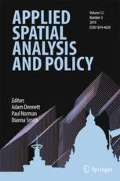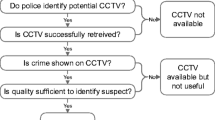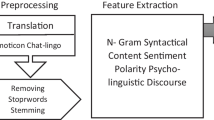Abstract
Prostitution has been a topic of study for decades, yet many questions remain about where prostitution occurs. Difficulty in identifying prostitution activity is often attributed to the hidden and seemingly victimless nature of the crime. Despite numerous challenges associated with policing street prostitution, these encounters become more difficult to identify when they take place indoors, especially in locations away from public view, such as hotels. The purpose of this paper is to develop a strategy for identifying hotel facilities and surrounding areas that may be experiencing elevated levels of prostitution activity using high-volume, user-generated data, namely hotel reviews written by guests and posted to Travelocity.com. A unique synthesis of methods including data mining, natural language processing, machine learning, and basic spatial analysis are combined to identify facilities that may require additional law enforcement resources and/or social/health service outreach. Prostitution hotspots are identified within the city of Phoenix, Arizona and policy implications are discussed.






Similar content being viewed by others
Notes
Consider, for example, the variations in penalties for prostitutes between Arizona and Texas. In Arizona, there are no financial penalties, but the first, second, third offenses and fourth offenses confer 15, 30, 60 and 180 days of jail time, respectively. In Texas, the first, second and third offenses confer up to 180 days and/or $2000, 1 year and/$4000, 2 years and/or $10,000, respectively (Procon 2017). There are equally diverse penalties for customers, pimps and brothel owners across all 50 states.
In the U.S., the religious right refers to a loose coalition of evangelical Protestants, Latter Day Saints, Roman Catholics, and other groups that support socially conservative policies on prostitution, contraception, abortion and homosexuality. Weitzer (2010, 64) defines abolitionist feminists as those “who argue that the sex industry should be eliminated because of its objectification and oppressive treatment of women, considered to be inherent in sex for sale.”
This list was obtained from the “MySQL Stopwords” list at http://www.ranks.nl/stopwords/.
Predictive models are different from exploratory models in many ways. For a more thorough discussion, readers should consult Shmueli (2010) or Mack and Grubesic (2009). In short, issues of multicollinearity, heteroskedasticity and endogeneity are important to correct in explanatory models, but this is not the case for good forecasting models.
Low-grade residential is a catch-all term for neighborhoods dominated by poor-quality housing, which includes trailer parks, poorly constructed multi-family apartment buildings and single-family houses.
This was not placed in the Commerceplex by the authors.
References
Anstine, J. (2003). Property values in a low populated area when dual noxious facilities are present. Growth and Change, 34 (3), 345–358.
Barnard, M. A. (1993). Violence and vulnerability: conditions of work for streetworking prostitutes. Sociology of Health & Illness, 15(5), 683–705. https://doi.org/10.1111/j.1467-9566.1993.tb00368.x.
Benson, C., & Matthews, R. (2000). Police and prostitution: Vice squads in Britain. In R. Weitzer (Ed.), Sex for sale: Prostitution, pornography, and the sex industry (pp. 245–264). New York: Routledge.
Boels, D., & Verhage, A. (2016). Prostitution in the neighbourhood: impact on residents and implications for municipal regulation. International Journal of Law, Crime and Justice, 46, 43–56.
Bogomolov, A., Lepri, B., Staiano, J., Oliver, N., Pianesi, F., & Pentland, A. (2014). Once upon a crime: Towards crime prediction from demographics and mobile data. In Proceedings of the 16th international conference on multimodal interaction (pp. 427–434). New York: ACM. https://doi.org/10.1145/2663204.2663254.
Bojanowski, P., Grave, E., Joulin, A., & Mikolov, T. (2016). Enriching Word Vectors with Subword Information. ArXiv:1607.04606 [Cs]. Retrieved from http://arxiv.org/abs/1607.04606. Retrieved October 17, 2018.
Breiman, L. (2001). Random forests. Machine Learning, 45(1), 5–32.
Butcher, K. (2003). Confusion between prostitution and sex trafficking. The Lancet 361, (9373), 1983.
Census Bureau. (2017). State population totals and components of change: 2010–2017. Retrieved from: https://www.census.gov/data/datasets/2017/demo/popest/state-total.html. Retrieved October 17, 2018.
Chokshi, N. (2015). The religious states of America, in 22 maps. Washington Post. URL: https://tinyurl.com/ybalkfn3
Chudakov, B., Ilan, K., Belmaker, R. H., & Cwikel, J. (2002). The motivation and mental health of sex workers. Journal of Sex & Marital Therapy, 28(4), 305–315.
Church, S., Henderson, M., Barnard, M., & Hart, G. (2001). Violence by clients towards female prostitutes in different work settings: questionnaire survey. BMJ (Clinical Research Ed.), 322(7285), 524–525. https://doi.org/10.1136/bmj.322.7285.524.
Cunningham, S., & Kendall, T. D. (2011). Prostitution 2.0: The changing face of sex work. Journal of Urban Economics, 69(3), 273–287. https://doi.org/10.1016/j.jue.2010.12.001.
Cunningham, S., & Shah, M. (2014). Decriminalizing indoor prostitution: Implications for sexual violence and public health (working paper no. 20281). National Bureau of Economic Research. https://doi.org/10.3386/w20281
Dank, M.L., Khan, B., Downey, P.M., Kotonias, C., Mayer, D., Owens, C., ... & Yu, L. (2014). Estimating the size and structure of the underground commercial sex economy in eight major US cities (p. 348). Washington, DC: Urban Institute.
Day, S. E., & Ward, H. (2007). British policy makes sex workers vulnerable. BMJ (Clinical Research Ed.), 334, 185–187. https://doi.org/10.1136/bmj.39104.638785.59.
Domingos, P. (2012). A few useful things to know about machine learning. Communications of the ACM, 55(10), 78–87.
Farber, S. (1998). Undesirable facilities and property values: a summary of empirical studies. Ecological Economics, 24(1), 1–14.
Farley, M. (2007). Prostitution and trafficking in Nevada: Making the connections. San Francisco: Prostitution Research & Education.
Farley, M., & Barkan, H. (1998). Prostitution, violence, and posttraumatic stress disorder. Women & Health, 27(3), 37–49.
Farley, M., & Kelly, V. (2000). Prostitution: a critical review of the medical and social sciences literature. Women & Criminal Justice, 11(4), 29–64.
Gerber, M. S. (2014). Predicting crime using Twitter and kernel density estimation. Decision Support Systems, 61, 115–125. https://doi.org/10.1016/j.dss.2014.02.003.
Gil, V. E., Wang, M. S., Anderson, A. F., Lin, G. M., & Wu, Z. O. (1996). Prostitutes, prostitution and STD/HIV transmission in mainland China. Social Science & Medicine, 42(1), 141–152.
Gossop, M., Powis, B., Griffiths, P., & Strang, J. (1995). Female prostitutes in South London: use of heroin, cocaine and alcohol, and their relationship to health risk behaviours. AIDS Care, 7(3), 253–260.
Gozdziak, E. M., & Collett, E. A. (2005). Research on human trafficking in North America: a review of literature. International Migration, 43(1–2), 99–128.
Grubesic, T. H. (2006). On the application of fuzzy clustering for crime hot spot detection. Journal of Quantitative Criminology, 22(1), 77–105.
Grubesic, T. H., & Murray, A. T. (2008). Sex offender residency and spatial equity. Applied Spatial Analysis and Policy, 1(3), 175–192.
Harcourt, C., O'connor, J., Egger, S., Fairley, C. K., Wand, H., Chen, M. Y., ... & Donovan, B. (2010). The decriminalisation of prostitution is associated with better coverage of health promotion programs for sex workers. Australian and New Zealand Journal of Public Health, 34(5), 482–486.
Havocscope. (2015). Prostitution: Prices and statistics of the global sex trade. Havocscope Books. Digital. 1st ed. Retrieved from: https://www.havocscope.com/prostitution-book/. Retrieved October 17, 2018.
Heiges, M. (2009). From the inside out: reforming state and local prostitution enforcement to combat sex trafficking in the United States and abroad. Minnesota Law Review, 94, 428.
Hubbard, P. (1997). Red-light districts and toleration zones: geographies of female street prostitution in England and Wales. The Royal Geographical Society, 29(2), 129–140. https://doi.org/10.1111/j.1475-4762.1997.tb00015.x.
Hubbard, P. (1998). Community action and the displacement of street prostitution: evidence from British cities. Geoforum, 29(3), 269–286.
Hubbard, P., Boydell, S., Crofts, P., Prior, J., & Searle, G. (2013). Noxious neighbours? Interrogating the impacts of sex premises in residential areas. Environment and Planning A, 45(1), 126–141.
Huff, J., Wallace, D., Riggs, C., Katz, C. & Choate, D. (2018). Examining the association between massage parlors and neighborhood crime. Crime & Delinquency. Online first: https://doi.org/10.1177/0011128718787154.
Jeal, N., & Salisbury, C. (2007). Health needs and service use of parlour-based prostitutes compared with street-based prostitutes: a cross-sectional survey. BJOG: An International Journal of Obstetrics & Gynaecology, 114(7), 875–881.
Kaufman, L., & Rousseeuw, P. J. (2009). Finding groups in data: An introduction to cluster analysis (Vol. 344). Hoboken: Wiley.
Kempadoo, K., Sanghera, J., & Pattanaik, B. (2015). Trafficking and prostitution reconsidered: New perspectives on migration, sex work, and human rights. Abingdon: Routledge.
Krüsi, A., Kerr, T., Taylor, C., Rhodes, T., & Shannon, K. (2016). “They won”t change it back in their heads that we’re trash’: the intersection of sex work-related stigma and evolving policing strategies. Sociology of Health & Illness, 38(7), 1–14. https://doi.org/10.1111/1467-9566.12436.
Levy, O., Goldberg, Y., & Dagan, I. (2015). Improving distributional similarity with lessons learned from word embeddings. Transactions of the Association for Computational Linguistics, 3(0), 211–225.
Larsen, E. N. (1992). The politics of prostitution control: interest group politics in four Canadian cities. International Journal of Urban and Regional Research, 16, 169–189.
Liu, Y., Kliman-Silver, C., & Mislove, A. (2014). The tweets they are a-Changin: evolution of Twitter users and behavior. ICWSM, 30, 5–314.
Lowman, J. (2000). Violence and the outlaw status of (street) prostitution in Canada. Violence Against Women, 6, 987–1011.
Mack, E. A., & Grubesic, T. H. (2009). Forecasting broadband provision. Information Economics and Policy, 21(4), 297–311.
Malleson, N., & Andresen, M. A. (2015). Spatio-temporal crime hotspots and the ambient population. Crime Science, 4(1), 10. https://doi.org/10.1186/s40163-015-0023-8.
Mansfield, C., Van Houtven, G., & Huber, J. (2001). The efficiency of political mechanisms for siting nuisance facilities: are opponents more likely to participate than supporters? The Journal of Real Estate Finance and Economics, 22(2), 141–161.
Matthews, R. (2005). Policing prostitution: ten years on. British Journal of Criminology, 45(6), 877–895. https://doi.org/10.1093/bjc/azi046.
McCleary, R., & Weinstein, A. C. (2009). Do “off-site” adult businesses have secondary effects? Legal doctrine, social theory, and empirical evidence. Law & Policy, 31(2), 217–235.
McCutcheon, J. C., Mustaine, E. E., & Tewksbury, R. (2016). Working the stroll: prostitutes, Pimps, and Johns. Deviant Behavior, 37(12), 1449–1458. https://doi.org/10.1080/01639625.2016.1185882.
Mikolov, T., Chen, K., Corrado, G., & Dean, J. (2013). Efficient estimation of word representations in vector space. ArXiv:1301.3781 [Cs]. Retrieved from http://arxiv.org/abs/1301.3781. Retrieved October 17, 2018.
Milrod, C., & Monto, M. (2016). Condom use, sexual risk, and self-reported STI in a sample of older male clients of heterosexual prostitution in the United States. American Journal of Men's Health, 10(4), 296–305.
Opaluch, J. J., Swallow, S. K., Weaver, T., Wessells, C. W., & Wichelns, D. (1993). Evaluating impacts from noxious facilities: including public preferences in current siting mechanisms. Journal of Environmental Economics and Management, 24(1), 41–59.
Oxford [Oxford English Dictionary]. (2018). Prostitution. URL: https://en.oxforddictionaries.com/definition/prostitution
Pedregosa, F., Varoquaux, G., Gramfort, A., Michel, V., Thirion, B., Grisel, O., … Duchesnay, É. (2011). Scikitlearn: machine learning in python. Journal of Machine Learning Research, 12, 2825–2830.
Prior, J., & Croft, P. (2012). Effects of sex premises on neighbourhoods: residents, local planning and the geographies of a controversial land use. New Zealand Geographer, 68, 130–140. https://doi.org/10.1111/j.1745-7939.2012.01228.x.
Procon. (2017). US federal and state prostitution laws and related punishments. URL: https://prostitution.procon.org/view.resource.php?resourceID=000119
Raphael, J., & Shapiro, D. L. (2004). Violence in indoor and outdoor prostitution venues. Violence Against Women, 10(2), 126–139. https://doi.org/10.1177/1077801203260529.
Roe-Sepowitz, D. E., Hickle, K. E., Loubert, M. P., & Egan, T. (2011). Adult prostitution recidivism: risk factors and impact of a diversion program. Journal of Offender Rehabilitation, 50(5), 272–285. https://doi.org/10.1080/10509674.2011.574205.
Sanders, T. (2004). The risks of street prostitution: punters, police and protesters. Urban Studies, 41(9), 1703–1717. https://doi.org/10.1080/0042098042000243110.
Schauer, E. J., & Wheaton, E. M. (2006). Sex trafficking into the United States: a literature review. Criminal Justice Review, 31(2), 146–169.
Schill, M. H., Ellen, I. G., Schwartz, A. E., & Voicu, I. (2002). Revitalizing inner-city neighborhoods: New York city’s ten-year plan. Housing Policy Debate, 13(3), 529–566. https://doi.org/10.1080/10511482.2002.9521454.
Shannon, K., Rusch, M., Shoveller, J., Alexson, D., Gibson, K., & Tyndall, M. W. (2008). Mapping violence and policing as an environmental-structural barrier to health service and syringe availability among substance-using women in street-level sex work. International Journal of Drug Policy, 19(2), 140–147. https://doi.org/10.1016/j.drugpo.2007.11.024.
Shmueli, G. (2010). To explain or to predict? Statistical Science, 25(3), 289–310.
Smith, C. J., & Hanham, R. Q. (1981). Any place but here! Mental health facilities as noxious neighbors. The Professional Geographer, 33(3), 326–334.
Steenbeek, W., Völker, B., Flap, H., & Oort, F. v. (2012). Local businesses as attractors or preventers of neighborhood disorder. Journal of Research in Crime and Delinquency, 49(2), 213–248. https://doi.org/10.1177/0022427810397948.
Van den Hoek, J. A., van Haastrecht, H. J., Scheeringa-Troost, B., Goudsmit, J., & Coutinho, R. A. (1989). HIV infection and STD in drug addicted prostitutes in Amsterdam: potential for heterosexual HIV transmission. Genitourinary Medicine, 65(3), 146–150.
Wallace, D. (n.d.). Prostitution at hotels in Phoenix, AZ: Final report prepared for the Sandra Day O’Connor Institute. Demanding Justice Arizona. Retrieved from: https://sharedhope.org/wpcontent/uploads/2015/05/Arizona-Field-Assessment-Report-ONLINE.pdf. Retrieved October 17, 2018.
Wang, X., Gerber, M. S., & Brown, D. E. (2012). Automatic crime prediction using events extracted from twitter posts. In Social computing, behavioral - cultural modeling and prediction (pp. 231–238). Berlin, Heidelberg: Springer. https://doi.org/10.1007/978-3-642-29047-3_28.
Weitzer, R. (1999). Prostitution control in America: rethinking public policy. Crime, Law and Social Change, 32(1), 83–102.
Weitzer, R. (2000a). The politics of prostitution in America. In R. Weitzer (Ed.), Sex for sale: Prostitution, pornography, and the sex industry (pp. 159–180). New York: Routledge.
Weitzer, R. (2000b). Why we need more research on sex work. In R. Weitzer (Ed.), Sex for sale: Prostitution, pornography, and the sex.
Weitzer, R. (Ed.). (2009). Sex for sale: Prostitution, pornography, and the sex industry. Routledge.
Weitzer, R. (2010). The movement to criminalize sex work in the United States. Journal of Law and Society, 37(1), 61–84.
Willis, B. M., & Levy, B. S. (2002). Child prostitution: global health burden, research needs, and interventions. The Lancet, 359(9315), 1417–1422.
Winstanley, E. L., Steinwachs, D. M., Ensminger, M. E., Latkin, C. A., Stitzer, M. L., & Olsen, Y. (2008). The association of self-reported neighborhood disorganization and social capital with adolescent alcohol and drug use, dependence, and access to treatment. Drug and Alcohol Dependence, 92(1), 173–182. https://doi.org/10.1016/j.drugalcdep.2007.07.012.
Yates, G. L., MacKenzie, R. G., Pennbridge, J., & Swofford, A. (1991). A risk profile comparison of homeless youth involved in prostitution and homeless youth not involved. Journal of Adolescent Health, 12(7), 545–548.
Young, A., Boyd, C., & Hubbell, A. (2000). Prostitution, drug use, and coping with psychological distress. Journal of Drug Issues, 30(4), 789–800. https://doi.org/10.1177/002204260003000407
Author information
Authors and Affiliations
Corresponding author
Ethics declarations
Conflict of Interest
The authors declare that they have no conflict of interest.
Rights and permissions
About this article
Cite this article
Helderop, E., Huff, J., Morstatter, F. et al. Hidden in Plain Sight: A Machine Learning Approach for Detecting Prostitution Activity in Phoenix, Arizona. Appl. Spatial Analysis 12, 941–963 (2019). https://doi.org/10.1007/s12061-018-9279-1
Received:
Accepted:
Published:
Issue Date:
DOI: https://doi.org/10.1007/s12061-018-9279-1




